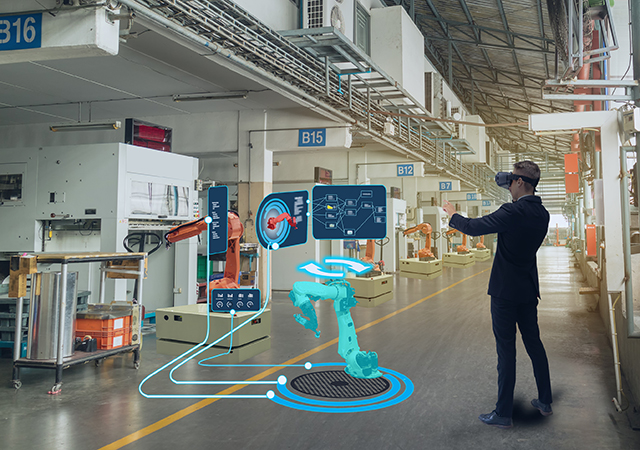

The global augmented and virtual reality (AR/VR) market in the healthcare sector is expected to experience remarkable growth in the coming years. According to a report by Dimension Market Research, the market size is projected to reach $19.6 billion by 2033, growing at a Compound annual growth rate (CAGR) of 20.2 per cent from 2025.
Currently, the global AR/VR in healthcare market was valued at $3.7 billion in 2024. This rapid expansion is driven by the increasing adoption of these transformative technologies across various healthcare applications, including medical education, surgical procedures, patient care management, and more.
KEY INSIGHTS
Hardware Dominance and Software Growth: The hardware segment, encompassing devices like head-mounted displays, smart glasses, and 3D sensors, is expected to dominate the AR/VR healthcare market in 2024. However, the software segment is poised for rapid growth, driven by advancements in technology and indicating a promising future for software-based solutions in the healthcare industry.
AR Technology Leadership: The augmented reality (AR) segment is anticipated to command the largest revenue share in 2024, driven by the increased adoption of immersive devices and ongoing technological advancements. AR's ability to seamlessly integrate digital information with the real-world environment has made it a valuable tool for healthcare professionals in areas such as diagnostics and surgical procedures.
Surgical Applications Lead the Way: The surgery segment is expected to hold a significant market share in 2024, driven by technological developments, streamlined medical procedures, and collaborations among AR technology players, all of which are promoting innovation in healthcare.
North America Dominates: North America is predicted to lead the AR/VR in healthcare market in 2024, capturing 51.1 per cent of the total revenue. This is attributed to the region's increased technology adoption, significant R&D investments, and supportive government initiatives, such as the U.S. National Institute of Health's funding of virtual reality healthcare research.
EMERGING TRENDS AND APPLICATIONS
Eldercare and Cognitive Health: AR and VR technologies are making significant contributions to eldercare by providing therapeutic applications that improve the overall well-being of seniors. These include cognitive exercises, memory enhancement programs, and immersive experiences designed to address age-related challenges. By integrating these technologies into eldercare, caregivers can offer stimulating and enjoyable activities, promoting better health and mental well-being among the elderly population.
Dementia and Alzheimer's Management: AR and VR interventions have proven valuable in addressing cognitive health concerns, such as dementia and Alzheimer's disease. These immersive experiences can stimulate memory, cognition, and sensory perception, providing therapeutic benefits for individuals with cognitive impairments.
Promoting Independent Living: AR and VR platforms can simulate real-world scenarios, enabling users to practice daily activities in a safe and controlled environment. This not only builds confidence but also promotes independent living for seniors and individuals with long-term medical concerns, enhancing their quality of life.
COMPETITIVE LANDSCAPE
The AR/VR in healthcare market is characterised by moderate competition, with major players investing heavily in research and development, technological advancements, and strategic collaborations. These factors shape the market dynamics, highlighting the importance of innovation, financial investments, and partnerships in the ongoing development and growth of the industry.
REGIONAL ANALYSIS
North America is predicted to maintain its dominance in the AR/VR in healthcare market, capturing 51.1 per cent of the total revenue in 2024. This is driven by the region's increased adoption of these technologies, substantial R&D investments, and supportive government initiatives, such as the U.S. National Institute of Health's funding of virtual reality healthcare research.
Additionally, the rise in outsourcing healthcare IT services in North America, driven by the imperative to lower treatment costs, is expected to contribute to the region's market growth.
The Asia-Pacific region is also anticipated to experience rapid growth, fueled by growing public awareness and advancing healthcare infrastructure, particularly in emerging economies like India and China. This provides significant opportunities for outsourcing services related to AR and VR technology development and deployment in the healthcare sector.
DRIVERS AND RESTRAINTS
Drivers: Telemedicine Adoption: The rise of telemedicine, enabled by AR and VR technologies, is crucial in providing remote healthcare services. These technologies facilitate virtual doctor-patient interactions, remote monitoring, and therapy sessions, improving accessibility to healthcare and fueling market growth.
Aging Population and Chronic Diseases: The global increase in the elderly population and the prevalence of chronic diseases have created a demand for innovative healthcare solutions, driving the growth of the AR/VR in healthcare market.
Restraints: High Costs: The significant costs associated with developing, acquiring, and maintaining AR and VR software and hardware present challenges, especially for smaller healthcare institutions in resource-limited regions. The initial investment required for specialised equipment and software licenses can act as a barrier, impeding the expansion of this market.
Ethical and Legal Concerns: As AR and VR technology become more integrated into healthcare, ethical and legal concerns emerge, encompassing matters such as patient consent, data privacy, accountability for virtual medical errors, and the risk of addiction or misuse of VR experiences.
OPPORTUNITIES
Surgical Applications: Virtual reality is becoming more prevalent in surgical settings due to its capacity to offer in-depth visuals of patient physiology and anatomy. It aids in better comprehension and preparation for surgeries, while also improving precision and accuracy in complex procedures, opening up numerous growth prospects for the market.
Workflow Optimisation: Virtual reality contributes to optimising healthcare workflows by simplifying data visualisation, patient monitoring, and medical record-keeping. It boosts efficiency, decreases administrative loads, and improves overall healthcare delivery, presenting valuable opportunities for market growth.
